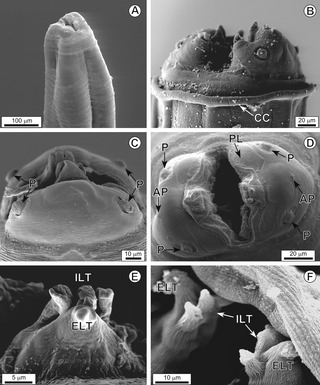Acanthocheilonema is a genus within the family Onchocercidae which comprises mainly tropical parasitic worms. Cobbold created the genus Acanthocheilonema with only one species, Acanthocheilonema dracunculoides, which was collected from aardwolf in the region of South Africa in the nineteenth century. These parasites have a wide range of mammalian species as hosts, including members of Carnivora, Macroscelidea, Rodentia, Pholidota, Edentata, and Marsupialia. Many species among several genera of filarioids exhibit a high degree of endemicity in studies done on mammalian species in Japan. However, no concrete evidence has confirmed any endemic species in the genus Acanthocheilonema.

The nematodes, roundworms or eelworms constitute the phylum Nematoda. They are a diverse animal phylum inhabiting a broad range of environments. Most species are free-living, feeding on microorganisms, but many species are parasitic. The parasitic worms (helminths) are the cause of soil-transmitted helminthiases.
Syndinium is a cosmopolitan genus of parasitic dinoflagellates that infest and kill marine planktonic species of copepods and radiolarians. Syndinium belongs to order Syndiniales, a candidate for the uncultured group I and II marine alveolates. The lifecycle of Syndinium is not well understood beyond the parasitic and zoospore stages.

Huffmanela is a genus of parasitic nematodes, belonging to the family Trichosomoididae.

The Trichosomoididae is a family of nematodes.

Huffmanela hamo is a parasitic nematode. It has been observed in the muscles of the dagger-tooth pike conger Muraenesox cinereus, a muraenesocid marine fish off Japan. Its life-cycle is unknown.

Cucullanus is a genus of parasitic nematodes. The genus includes more than 100 species.
Trophomera marionensis is a deep-sea nematode endoparasite of the family Benthimermithidae. They can be found in one of the deepest parts of the ocean, for example, in the hadal zone 7,000 to 10,000 meters below sea level. They exist in relentless darkness under immense water pressure. Marine invertebrates are their definitive hosts. They infest a wide range of invertebrate marine hosts: polychaete, priapulids, crustaceans, and even other nematodes. Death of their host can result if they occupy the entire body, at which point they exit and reproduce.

Physalopteridae is a family of spirurian nematodes, which belongs to the superfamily Physalopteroidea. Like all nematodes, they have neither a circulatory nor a respiratory system.

František Moravec is a Czech parasitologist who specialises on the Nematodes, especially the nematodes parasites of fishes. His research is mainly in the field of taxonomy of the Nematoda.

Cystidicolidae is a family of spirurian nematodes. It was described by Skrjabin in 1946. All members of the family are parasites of fish.
Cystidicola is a genus of parasitic nematodes, belonging to the family Cystidicolidae. Species of Cystidicola are parasitic in the swimbladder of fish.

Ascarophis is a genus of parasitic nematodes, belonging to the family Cystidicolidae. Species of Ascarophis are parasitic as adults in the gastrointestinal tract of marine and estuarine fishes.

Ascarophisnema is a genus of parasitic nematodes, belonging to the family Cystidicolidae. Species of Ascarophisnema are parasitic as adults in the gastrointestinal tract of fish. According to the World Register of Marine Species, the genus currently (2019) includes a single species, Ascarophisnema tridentatum.
Metabronemoides is a genus of parasitic nematodes, belonging to the family Cystidicolidae. Species of Metabronemoides are parasitic as adults in the gastrointestinal tract of fish.

Moravecnema is a genus of parasitic nematodes, belonging to the family Cystidicolidae. Species of Moravecnema are parasitic as adults in the gastrointestinal tract of fish. According to the World Register of Marine Species, the genus currently (2019) includes a single species, Moravecnema segonzaci, which is a parasite in a deep-sea fish.
Spinitectoides is a genus of parasitic nematodes, belonging to the family Cystidicolidae. Species of Spinitectoides are parasitic as adults in the gastrointestinal tract of fish. According to the World Register of Marine Species, the genus currently (2019) includes a single species, Spinitectoides berlandi.
Prospinitectus is a genus of parasitic nematodes, belonging to the family Cystidicolidae. Species of Prospinitectus are parasitic as adults in the gastrointestinal tract of Tuna fish.
Terranova is a genus of parasitic nematodes. Species from this genus are known to parasitise sharks, rays, sawfishes, teleosts and crocodilians.

Ichthyofilaroides is a genus of parasitic nematodes, belonging to the family Guyanemidae Petter, 1974.











